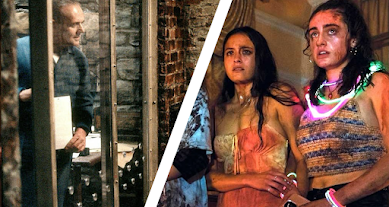The Substance's Gruesome Body Horror: A Film on Beauty
Coralie Fargeat's sophomore feature "The Substance" is a body horror film that has left many viewers with visceral reactions. The horrifying imagery across the screen, however, is not the cause of this disturbance. Instead, it is the emotions that the characters convey.
The film follows main character, Elisabeth Sparkle, as she faces the reality of ageing as a woman in the entertainment industutry when she loses her job on her 50th birthday. Through the film, she actively grows more willing to do whatever it takes to reverse the effects of turning 50 and stay a star, even if that means destroying herself along the way.
This is a movie that uses the body horror genre not for shock value, but to tackle issues of ageism and sexism. This is through an extreme juxtaposition between the way that a woman's body is viewed by society when young versus aged.
The juxtaposition begins subtle, with details as simple as lighting and color. When Elisabeth is on screen, the visuals appear dull and lifeless. When Sue, Elisabeth's "better" self takes over, the pictures are more colorful and full of life. Her beginning scenes are akin to that of a Diet Coke commercial, like the can she held in her hand, highlighting her youthful beauty through objectification.
It is clear through the objectification of Sue that neither of these versions of life are perfect for Elisabeth, although she seems to think her Sue-self is. The reality is that in either her Sue or Elisabeth self, the majority of the men around her in the film treat her as though she is nothing more than her appearance without acknowledgement of who she is as a person.
This treatment is a result of the systems of the patriarchy that boil women down to their bodies. It is not about what Elisabeth looks like. Still, she feels this way because society has taught her that she is the one who is wrong and she cannot find her way around that.
These same men in the movie who are judging Elisabeth for her natural aging are shown in scenic lighting that highlights their own age and physical flaws. Regardless, these men continue to keep their jobs in powerful business positions. This highlights the sexism within ageism through yet another well portrayed visual juxtaposition.
Another device used throughout the film is the motif of "You are one." This reminder is given every time that Sue does not respect the balance. This is a phrase repeated over and over through the film that goes deeper than the time share connection between the two. It is a reminder that Sue does not respect herself.
Film director and creator Coralie Fargeat discussed this idea in an interview, comparing the Sue self vs Elisabeth self as an internal battle. Fargeat said "You can feel good, and you can feel extremely bad. And showing that for real in another [physical] being, as the other voice, I thought was the most powerful way to kind of represent this battle. This kind of super violent conflict that we have within us, and whether it is towards the food, or towards judging herself for not being perfect."
This lack of self respect is what led to the battle between Sue and Elisabeth in which they fight to the death. Coralie Fargeat touches on this too in the interview when she said "The fact that at the end Sue wants to kill Elisabeth because she hates what she represents and the external violence of it was really a way to kind of externalize for real all of this internal violence that we have within us regarding those issues."



Hello Kenzie!
ReplyDeleteThis was such an interesting post! I loved your emphasis on how lightning and visual juxtapositions work in films like The Substance to show rather than simply tell the audience what they should be paying attention to. At points, however, I did feel like I was reading an essay more than a blog post, which wasn't a problem at all for me, but I do wonder if there'd be a way to break some of your points up into more digestible pieces! I look forward to your next post!
Good post. It is clear that this is a topic that you are passionate about. For your source, be sure to give enough information that the audience trusts the inclusion of that source--and link to the where the quote is taken from if possible. Also, be sure to give credit for the images--they are copyrighted and the creators deserve credit.
ReplyDelete